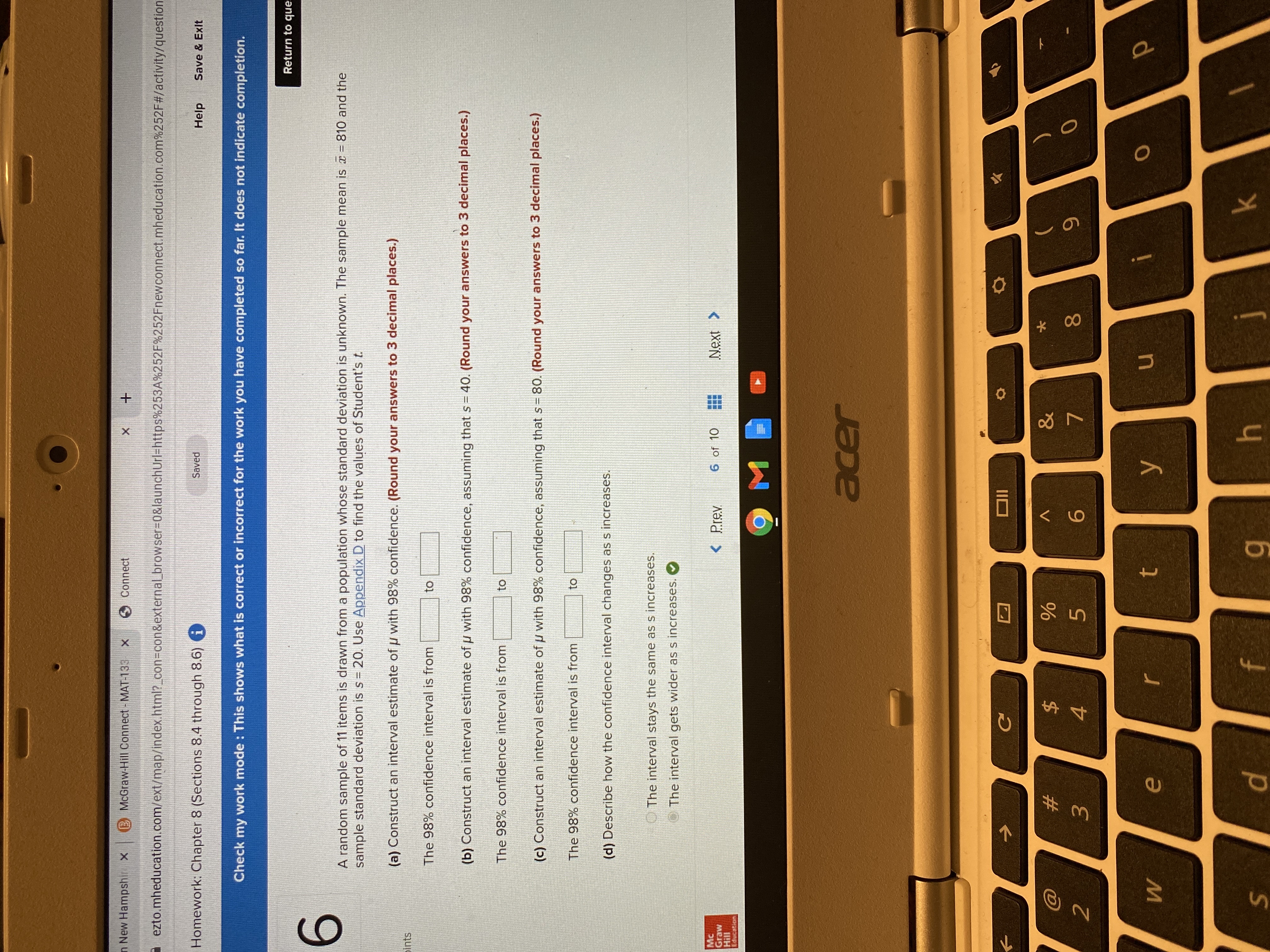
MATLAB: An Introduction with Applications
6th Edition
ISBN: 9781119256830
Author: Amos Gilat
Publisher: John Wiley & Sons Inc
expand_more
expand_more
format_list_bulleted
Concept explainers
Topic Video
Question
Help !!

Transcribed Image Text:**Exercise: Confidence Interval Estimation**
A random sample of 11 items is drawn from a population whose standard deviation is unknown. The sample mean is \( \bar{x} = 810 \) and the sample standard deviation is \( s = 20 \). Use Appendix D to find the values of Student’s t.
**(a)** Construct an interval estimate of \( \mu \) with 98% confidence. *(Round your answers to 3 decimal places.)*
The 98% confidence interval is from _______ to _______.
**(b)** Construct an interval estimate of \( \mu \) with 98% confidence, assuming that \( s = 40 \). *(Round your answers to 3 decimal places.)*
The 98% confidence interval is from _______ to _______.
**(c)** Construct an interval estimate of \( \mu \) with 98% confidence, assuming that \( s = 80 \). *(Round your answers to 3 decimal places.)*
The 98% confidence interval is from _______ to _______.
**(d)** Describe how the confidence interval changes as \( s \) increases.
- The interval stays the same as \( s \) increases.
- The interval gets wider as \( s \) increases. (Correct)
*Note: Please refer to the table in Appendix D for the appropriate t values for constructing these confidence intervals.*
Expert Solution
arrow_forward
Step 1
From the given information,
Sample size n =11
sample mean, x̅=810
sample standard deviation, s=20
Confidence level = 98%
Degrees of freedom: 24(=25-1).
Using Excel function, “=T.INV.2T (0.02,10)”, the critical value for two-tailed test at 98% confidence level is 2.7638.
The standard error is:
Margin of error:
Confidence interval:
The 98% confidence interval is from 793.334 to 826.666.
Step by stepSolved in 4 steps

Knowledge Booster
Learn more about
Need a deep-dive on the concept behind this application? Look no further. Learn more about this topic, statistics and related others by exploring similar questions and additional content below.Similar questions
- -3 -5 2 -3 -5 2 f. Suppose that E6 -2 -3 -3 -2 -3 -3 3 -4 -11 -22 Find E, and E,. E6 =arrow_forwardShowing the details, calculate the following expressions or give reason why they are not defined, when A = 3 1 -3 1 -3 4 2 2 5 u= 2 0 -5 0 B = -4 V = -3 3 4 0-2 2 0arrow_forwardWhich of the following scatterplots is best described as displaying a strong, positive linear relationship between x and y? (A) y 4 3 2 1 0 20 10 5 (B) y 4 3 2 1 0 60 ՋՈ 106 (D) 5 4 4 3 3 2 2 1 1 0 0arrow_forward
arrow_back_ios
arrow_forward_ios
Recommended textbooks for you
 MATLAB: An Introduction with ApplicationsStatisticsISBN:9781119256830Author:Amos GilatPublisher:John Wiley & Sons Inc
MATLAB: An Introduction with ApplicationsStatisticsISBN:9781119256830Author:Amos GilatPublisher:John Wiley & Sons Inc Probability and Statistics for Engineering and th...StatisticsISBN:9781305251809Author:Jay L. DevorePublisher:Cengage Learning
Probability and Statistics for Engineering and th...StatisticsISBN:9781305251809Author:Jay L. DevorePublisher:Cengage Learning Statistics for The Behavioral Sciences (MindTap C...StatisticsISBN:9781305504912Author:Frederick J Gravetter, Larry B. WallnauPublisher:Cengage Learning
Statistics for The Behavioral Sciences (MindTap C...StatisticsISBN:9781305504912Author:Frederick J Gravetter, Larry B. WallnauPublisher:Cengage Learning Elementary Statistics: Picturing the World (7th E...StatisticsISBN:9780134683416Author:Ron Larson, Betsy FarberPublisher:PEARSON
Elementary Statistics: Picturing the World (7th E...StatisticsISBN:9780134683416Author:Ron Larson, Betsy FarberPublisher:PEARSON The Basic Practice of StatisticsStatisticsISBN:9781319042578Author:David S. Moore, William I. Notz, Michael A. FlignerPublisher:W. H. Freeman
The Basic Practice of StatisticsStatisticsISBN:9781319042578Author:David S. Moore, William I. Notz, Michael A. FlignerPublisher:W. H. Freeman Introduction to the Practice of StatisticsStatisticsISBN:9781319013387Author:David S. Moore, George P. McCabe, Bruce A. CraigPublisher:W. H. Freeman
Introduction to the Practice of StatisticsStatisticsISBN:9781319013387Author:David S. Moore, George P. McCabe, Bruce A. CraigPublisher:W. H. Freeman

MATLAB: An Introduction with Applications
Statistics
ISBN:9781119256830
Author:Amos Gilat
Publisher:John Wiley & Sons Inc

Probability and Statistics for Engineering and th...
Statistics
ISBN:9781305251809
Author:Jay L. Devore
Publisher:Cengage Learning

Statistics for The Behavioral Sciences (MindTap C...
Statistics
ISBN:9781305504912
Author:Frederick J Gravetter, Larry B. Wallnau
Publisher:Cengage Learning

Elementary Statistics: Picturing the World (7th E...
Statistics
ISBN:9780134683416
Author:Ron Larson, Betsy Farber
Publisher:PEARSON

The Basic Practice of Statistics
Statistics
ISBN:9781319042578
Author:David S. Moore, William I. Notz, Michael A. Fligner
Publisher:W. H. Freeman

Introduction to the Practice of Statistics
Statistics
ISBN:9781319013387
Author:David S. Moore, George P. McCabe, Bruce A. Craig
Publisher:W. H. Freeman